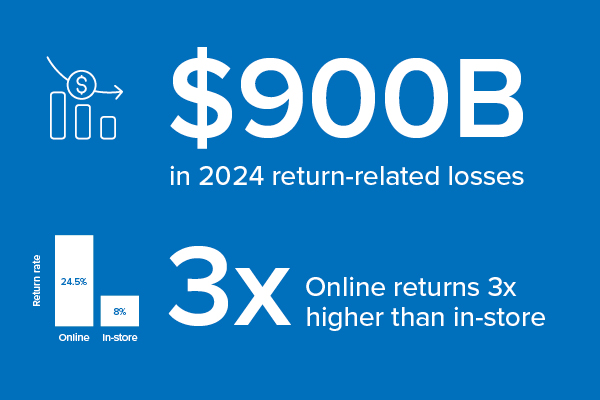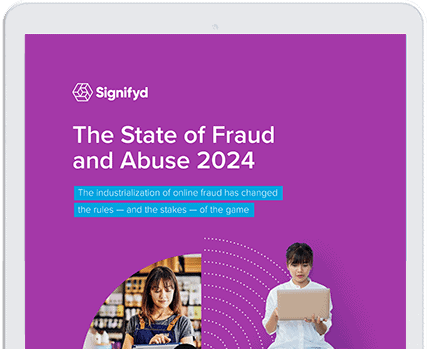Ecommerce return policies used to be easy: write simple rules, offer a return label, issue a refund. Done. But that approach just doesn’t hold up anymore.
Frequent return abuse, serial returners and policy loopholes have made merchants rethink how they design their policies. Rather than just serve as a post-purchase courtesy, modern online return policies need to act as an additional layer of defense — one that deters return abuse and protects profits without hurting customer experience.
Building a strong ecommerce return policy that strikes the right balance starts with understanding the fundamentals. That means knowing what a return policy really is and what makes it effective, as well as the strategies you can use to turn it from a basic formality into a revenue-safeguard.
What is an ecommerce return policy?
An ecommerce return policy defines return timing, conditions, fees and refund or exchange procedures.
Why do return policies matter for retailers?
Return policies have always been an important part of doing business, but they’re even more imperative for ecommerce merchants today since online returns have become so common. Online purchases are returned three times as often as in-store purchases, according to the 2024 ICSC Consumer Returns Data, and the NFR 2024 Consumer Trends report found that returns cost merchants nearly $900 billion in 2024.

Because of this, return policies must serve a more strategic purpose. Beyond offering basic guidelines and setting expectations, a well-designed policy needs to prevent fraud and protect profits while improving customer experience and building long-term brand loyalty, ultimately increasing customer lifetime value (CLVT) through strategic return optimization to ensure you maintain compliance with global and regional laws. Let’s see how.
Return fraud prevention and margin protection
An ecommerce return policy sets guardrails that prevent return abuse by establishing firm conditions, timeframes and requirements for eligibility. It also gives your support and fraud teams the structure they need to flag and respond to suspicious behavior early. This leads to fewer losses, fewer chargebacks and better protection for your bottom line.
Customer experience, conversions and loyalty
Shoppers are more likely to complete a purchase when they know they can easily return or exchange a product if the need arises. According to a 2024 European consumer survey commissioned by us, 77% of European consumers base their initial ecommerce shopping decisions on the merchant’s return policy.
Beyond helping conversion, your return policy also builds lasting trust in your brand when it’s clear, fair and easy to understand. And when it’s paired with a smooth post-purchase or easy return experience, that confidence transforms one-time buyers into loyal customers. In turn, those loyal customers become loud brand advocates.
Retention, repeat purchase rates and CLTV
Did you know a smooth return and refund process can leave an even better impression than an easy checkout experience? According to Signifyd’s 2025 State of Commerce Report,
62% of shoppers will buy more from a merchant after they’ve had a positive online return experience with them.
Why? Customers are far more likely to come back when they feel like their time is respected and their concerns are handled quickly. A well-handled return also shows that you stand behind your products and care about the post-purchase experience, building further trust in your brand. And over time, that trust can lead to higher retention, more frequent repeat purchases and stronger lifetime value.
Geographical legal obligations
While return policies serve as a valuable tool for customer experience and revenue protection, they’re also required by law in many parts of the world. But every region tends to have different legal requirements. For example, shoppers in the EU, Iceland and Norway have the right to return most products within 14 days with no questions asked. In the U.S., state-level regulations vary, and many regions require specific disclosures around return windows, restocking fees or refund timelines.
For merchants selling across borders, or even state lines, you have to make sure your return policy is compliant with all applicable consumer protection laws. Otherwise, you risk paying hefty noncompliance fines and navigating time-consuming (not to mention costly) disputes down the road.
How to reduce return rates without hurting conversions
Returns are an inevitable part of ecommerce — but many can be prevented with clear upfront communication. In fact, 51% of online returns take place because of mismatched expectations. More often than not, that disconnect stems from things like incomplete product descriptions, unclear sizing, poor color accuracy or images that don’t fully represent the actual product.
On the brightside, those issues can be easily fixed by providing clear item descriptions, accurate sizing and color guides and high-quality visuals. When your customers have more details, they can make more informed online purchase decisions, making them:
- Less likely to send items back
- More likely to make purchases in the future
That said, not all returns are created equal. Some are honest, while others are deliberate abuse of flexible policies. For example, fraudulent online returns cost merchants an estimated $46 billion in 2024. And these aren’t isolated incidents. They’re often the result of repeat behaviors like:
- Wardrobing: Wearing an item once before returning it
- Open-box fraud: Returning used or damaged products
- Product switching: Sending back fake or entirely different products in place of the original
Unfortunately, these types of return abuse steadily chip away at profit margins and can be hard to spot without the right systems in place. To stay protected without adding friction for honest customers, more merchants are turning to smarter tools that offer deeper insight into return behavior so they can respond better and faster.
![]()
How to use data and machine learning to drive profitability
Instead of applying the same return process to every shopper, smarter return management tools let you tailor your approach. For example, Signifyd’s Return Abuse Prevention solution uses machine learning and real-time data to automatically classify returns into categories based on risk. With this visibility, merchants can tailor automatic decisioning regarding which returns to fast-track and which to flag for review.
To support these decisions, Signifyd’s solution analyzes return activity at scale and uses anomaly detection to flag unusual patterns and repeat offenders, surfacing behaviors that may be costing your business the most.
It also tracks key metrics like return rates, repurchase rates and return contact rates, giving your team a clear view of how returns affect business. And by calculating true customer profitability, it helps you understand which customers are driving long-term value and which customers aren’t.
How to build a return policy that prevents fraud without damaging CX
Designing ecommerce return policies is a balancing act. Make them too strict, and you risk alienating loyal customers. Make them too lenient, and you open the door to return abuse.
So how do you strike the right balance? Start with a few foundational strategies that help protect your business without compromising the experience for honest customers.
Here are three tips to get started:
1. Be clear, consistent and customer-friendly
Your return policy should be easy to find, easy to understand and consistent across your channels. Be upfront about return windows, acceptable product conditions, which items are non-returnable and whether returns are free, conditional or have a restocking fee. Also, remember to use straightforward language that everyday people, not just lawyers, can understand.
2. Build guardrails that deter abuse
Instead of tightening your entire policy to stop a small percentage of bad actors, implement subtle safeguards that prevent abuse without frustrating honest customers. Consider introducing tactics like:
- Requiring a return authorization for high-risk SKUs
- Offering extended return windows only to loyalty members
- Using store credit instead of refunds for select return reasons or flagged behaviors
- Flagging repeat returners for manual review
These small adjustments let you maintain a flexible, friendly return policy for the majority of customers, while applying extra scrutiny where it’s needed.
3. Use data to guide your return decisions
Return behavior is one of the clearest signals of customer intent, and it’s also one of the most valuable tools in building an effective ecommerce return policy. By analyzing return trends across customers, products, geographies and sales channels, you can uncover patterns that point to risks and growth opportunities.
For example, you might find that a small segment of customers initiates returns far more often than average, suggesting a need for additional verification steps or modified refund policies for that group. Or, you might discover that you saw a spike in returns for a certain product after a new marketing campaign.
Ecommerce return policy best practices
Whether you’re creating a return policy from scratch or fine-tuning an existing one, the right approach can make all the difference. These strategies will help you build a strong policy that protects your business and supports your customers.
Define the priorities of your return policy
Before writing your return policy, take a step back and think about what exactly you’re trying to accomplish. Do you want to reduce return-related fraud? Lower reverse logistics costs? Improve customer retention? Encourage exchanges instead of refunds?
Your answers will shape everything from how long your return window should be to whether you offer store credit, refunds or both — and how strict your conditions need to be.
Ensure that your return policy is easy to find
A well-crafted return policy only helps if customers can actually find it.
Make sure your return policy is easily accessible at every stage of the buyer’s journey. Include a link in your website’s footer, on product detail pages and within the shopping cart so customers can review it before checking out. Follow through post-purchase by linking to the policy in confirmation emails, shipping notifications and return-related messages as well.
Answer the big three questions of a return policy
The most effective return policies spell out the basics upfront and present them in plain language. Your policy should clearly and quickly address the three questions customers care about most:
- Can I return this item?
- How much time do I have?
- Will the return cost me anything?
When these details are vague, shoppers are more likely to abandon their cart or flood your support team with questions.
Equip yourself to enforce your return policy
A policy is only as effective as your team’s ability to enforce it. Everyone involved, from support to fraud prevention, needs to know exactly how to handle returns. That means you need to have:
- Clear criteria for approving or rejecting returns
- Processes for tracking return volume and reasons
- Alignment with fraud review workflows (if applicable)
- The ability to manage exceptions without creating inconsistency
Returns technology is quickly evolving to help merchants better act upon their return policies. Signifyd’s Intelligent Returns suite, including Instant Refunds and Returns Insights, harnesses vast amounts of data and machine learning to provide merchants with visibility into the intent behind return requests.
Present as many return types as applicable
The more return options you offer, the more flexibility you have to protect revenue while giving customers a sense of control over the process.
Depending on your products and operations, this might include exchanges for a different size or color, store credit for certain return reasons or instant refunds for trusted customers.
Each option serves a purpose. Exchanges preserve the sale. Store credit keeps revenue in your ecosystem. Instant refunds delight loyal shoppers. Just make sure each option is clearly explained, so customers feel confident when initiating a return.
Offer at least one free return type
Free returns aren’t always necessary, but offering at least one no-cost option can ease purchase anxiety and lower cart abandonment.
Consider covering shipping on exchanges but not refunds, offering free returns for first-time buyers or making in-store drop-offs free while charging for mail-in returns. These kinds of hybrid models give customers a sense of flexibility while helping you control reverse-logistics costs.
Align your return policy with your brand
Everything in your return policy — from tone to terms — should reflect your brand’s values. If you’re all about sustainability, for example, your policy should echo that. Or, if you’re a high-end brand, your language should feel polished and premium at every touchpoint. By doing so, you create an authentic experience from pre- to post-purchase.
Conduct regular reviews
Customer expectations and fraud tactics change. So should your return policy.
Make it a habit to review your policy regularly, especially if you notice new patterns in return data, more fraud attempts or shifts in customer behavior. Staying proactive helps you spot vulnerabilities early and resolve small issues before they balloon into costly problems.
Example ecommerce return policy template
To help you put the above strategies into action, here’s a sample return policy template. Use it as a framework and adjust the details to match your specific needs.
Overview
At [Your Brand Name], we want you to love what you ordered. If something’s not quite right, we’re here to help.
We have a [Insert length, i.e. 30 day] return policy, starting from the day you receive your item, to request a return.
2. What can I return?
To be eligible for a return, you must provide your receipt or proof of purchase, and:
- The item must be in the same condition in which you received it
- The item must be unworn or unused
- The item must still have its tags attached
- The item must be in its original packaging
We reserve the right to decline return requests if patterns of abuse, such as frequent returns or use of items before returning, are detected.
3. What cannot be returned?
We cannot accept returns on final sale items, customized items, perishable items, gift cards or items that have been altered or damaged by the customer.
We also do not accept returns for hazardous materials, flammable liquids or gasses. Certain high-risk items, such as electronics and luxury goods, are non-returnable unless they are defective or damaged upon receipt.
4. Are there any fees for returns?
[Answer accordingly based on your policies]
5. How do I start a return?
To initiate a return, you can contact us at [Insert email address]. You’ll need your order number and the email address used at checkout.
If your return is accepted, we’ll send you a return shipping label, as well as instructions on how and where to send your package.
6. Damages and issues
Please inspect your order upon receipt and contact us within five days if the item is defective, damaged or if you receive the wrong item, so we can evaluate and address the issue promptly.
7. Exchanges
Need a different size, color or style? We offer free exchanges on eligible items within [Insert timeframe, i.e. 30 days) of delivery.
To request an exchange:
[Insert steps to request an exchange]
We’ll ship the exchange once the original item is scanned by the carrier or received at our facility.
Please note:
- Exchanges are subject to inventory availability
- Certain items (i.e. final sale or custom products) may not be eligible for an exchange
- If your requested item is out of stock, we’ll issue store credit or a refund based on your preference
8. Refunds
We will notify you once we’ve received and inspected your return to let you know if the refund was approved or not. If approved, you’ll be automatically refunded on your original payment method within [Insert number] business days. Refunds will only be issued to the original payment method used during the purchase. Please remember it can take some time for your bank or credit card company to process and post the refund too.
If more than [Insert number] business days have passed since we’ve approved your return, please contact us at [Insert email address].
Keep in mind that each merchant should thoughtfully consider your specific return policy needs. This template is a starting point and includes a number of requirements that you might want to modify in order to provide a better customer experience. We also recommend consulting with a legal professional to ensure your policy complies with applicable laws and aligns with your business.
How Intelligent drives return profitability for enterprise retailers
While returns can present a thorny customer experience challenge, the path ahead looks bright. Future-focused enterprise merchants are turning to Signifyd’s recently released Intelligent Returns suite to tackle complex challenges, reduce losses and significantly boost their bottom lines. The suite provides the next level of deep insights and automated decisions needed to transform retailers’ return operations from a cost center into a powerful revenue optimizer. Below is a series of real-life examples of how leading brands are achieving remarkable profitability gains with Signifyd’s returns solutions.

Enhance your return policy and transform returns into revenue protection
Finalizing your ecommerce return policy is only the first step. Even the best-written policy can fall short without the right tools behind it.
Signifyd’s Returns Insight and Intelligent Returns solutions are designed to close that gap — giving you better insight into return behavior, automatically classifying return types by intent and flagging patterns of abuse before they impact your bottom line. With this level of intelligence, you can enforce your policy with precision, reduce losses, safeguard revenue and maintain a seamless experience for your customers.
Ready to turn returns into a source of revenue protection? Let’s talk.
Frequently asked questions
What is the average return rate for online retailers?
The average return rate for ecommerce merchants can vary year-to-year and from industry-to-industry. According to a recent study, online retailers saw an average return rate of 24.5% in 2024.
What are the top reasons for customers returning products?
Sizing issues, color discrepancies and bracketing (where customers buy multiple versions of the same product) are the top reasons why customers return items they bought online.
How do return policies affect cart abandonment and conversion rates?
Unclear or strict return policies are more likely to cause shoppers to abandon their carts. On the flip side, transparent and flexible return policies build trust and encourage purchases. Studies show that 92% of customers are more likely to buy again from a retailer with an easy return process.
How can I prevent fraudulent returns without upsetting loyal customers?
The best ways to prevent return fraud without adding extra friction? Use data to spot abuse patterns and apply extra scrutiny only where needed. Keep your policy clear and consistent, and offer flexible options like store credit or instant refunds for trusted customers.
What is the best way to handle international returns?
The best way to handle international returns is to create a clear, region-specific return policy that outlines timelines, eligibility and who covers shipping costs. Consider also using localized return portals that generate accurate customs forms and labels to reduce potential delays.








